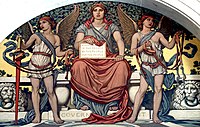
Photo from wikipedia
Abstract We investigate the empirical link between external debt composition and domestic credit cycles. Using quarterly data for 40 countries between 1980 and 2015, we show that two dimensions of… Click to show full abstract
Abstract We investigate the empirical link between external debt composition and domestic credit cycles. Using quarterly data for 40 countries between 1980 and 2015, we show that two dimensions of external debt composition (ie instrument type and lending/borrowing sector) provide valuable information about the likelihood of domestic credit booms and busts. In particular, we find that a higher share of external bank lending in the form of bonds is associated with a greater likelihood of credit booms. Our results also reveal that credit busts tend to be associated with a lower share of interbank lending and a higher share of lending from banks to non-banks. Additionally, the empirical evidence shows that external debt composition is a robust predictor of domestic credit booms and busts at a wide range of horizons. Thus, the information contained in the composition of external debt can be used to construct a set of “early-warning” indicators, which can help policymakers in their management of credit cycles.
Journal Title: Journal of International Money and Finance
Year Published: 2021
Link to full text (if available)
Share on Social Media: Sign Up to like & get
recommendations!